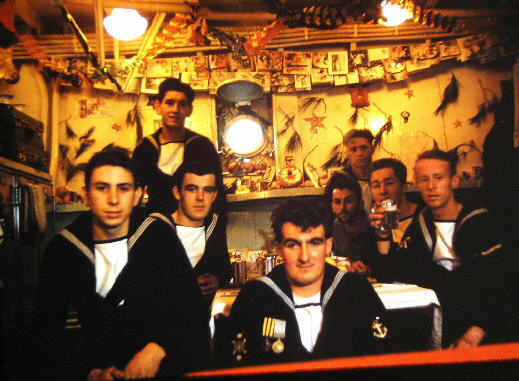THE SUEZ CRISIS
Rumours of trouble over the Suez Canal were circulating in late summer of 1956. These gave rise to uncertainty amongst the crew and letters from home (where there was better access to news) led us to believe that we might we involved in some activity in the western Med before long. The frequency of our patrols in the Cyprus area increased and eventually we were given a variety of tasks which confirmed that things were ‘hotting up’. It was about this time that the ‘man overboard’ incident occurred. We were used to convey War Correspondents, stores and Army personnel to the vicinity of the trouble spot. It was a very busy time for us, the detail of which I will not relate. But of interest is something that may have been forgotten. Manxman, as a fast minelayer, was equipped with some seldom used gear on her stern-sheets. There were two huge reels of ‘piano wire’. Apparently the wire could be paid out over the stern while the ship was moving (the remote end being fastened to a sinker). The length of the wire was carefully measured by a mechanism thus enabling the crew to determine very precisely the distances between the mines being laid and their exact positions shown on a chart. Though we did not carry any mines in these operations, some part of our job was to measure exact distances between the various points. The mining deck was quite extensive so the space was used for the carriage of soldiers and stores during this operation.
The journey east from Malta was one of the worst I can recall. The weather was very rough and the progress slow because we were escorting a fleet of small landing craft. The soldiers aboard Manxman had a very bad time. There was a lot sea-sickness so that much of the ship, below decks, was in a deeply unpleasant state. Conditions in the mining deck, where the soldiers were accommodated, must have been quite hellish.
Manxman was engaged in the bombardment of the Port Said area. I well remember the night of 5th November 1956 as the biggest (for us) Guy Fawkes Night ever! Many ships of several nations were lying off the Port. At times the air and sky seemed to be filled with shell-blasts and next morning we could see three huge plumes of smoke rising from the oil storage tanks which had been hit by the bombs and shelling. A Hospital Ship was lying a few hundred yards from us and helicopters were conveying wounded men to her. The saddest moment for me was when I saw a fatal incident involving a military helicopter. The aircraft was loaded with wounded personnel, so I understand. It was flying low when a huge wave caught its undercarriage and took it straight down like a stone, just a hundred and fifty yards from us. There were plenty of small boats scuttling around the area but nothing could be done, so far as I could see, apart from the rescue of one man who escaped in a life-raft.
Cease Fire
After the cease-fire, Manxman was directed to go into the Port area at the entrance to the Suez Canal. I don’t recall the precise purpose of this but of course we were carrying FOF Med (Fleet Officer Flotillas, Mediterranean) and probably other senior military personnel. As it happened, Manxman was the first ship to enter the head of the Canal, negotiating a route through the block-ships which had been deliberately sunk there by Col. Nasser. I was on duty in the Admiral’s Barge at the time so that I had opportunity to take a few shots of Manxman’s progress and the mayhem caused by Nasser.
In a picture that I took from Manxman’s deck when we were approaching the canal, one can clearly see the huge statue celebrating the man who supervised the building of the canal, Ferdinand de Lesseps. The following day terrorists blew up the statue, presumably to show their displeasure at what had taken place.
We returned to our berth in Sliema Harbour, Malta, on Christmas Day 1956. All of us were thoroughly weary after our experiences in the previous two months. Something of that weariness may be seen in the faces of the members of No. 14 Mess in this picture (below). Festive decorations were OK but we were thinking of families and longing to be home.

Pictured, left to right (apologies for the names I have forgotten) –
Myself - (Ord. Seaman Mike Salts)
Able Seaman ?? (standing)
Leading Seaman 'Jock' Murphy (ship’s ‘postman’)
Ord. Seaman John Elmer (youngest member of the mess, wearing someone else’s badges and medals – just for the photo!)
Ord. Seaman Nicky Coombes
Leading Seaman XX (standing; Leading hand of No. 14 mess)
Ord. Seaman Tony Hills; and Able Seaman ‘Pusser’ Hill.
.
.
.